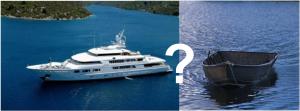
A Leadership Bell Curve
I’d like you to imagine leadership performance as a bell curve. We’ll distribute managers along the curve relative to how well they navigate the sea of market changes. In this scenario, those at the top 10% of the curve are called Superstars and Visionaries. The former possess the lunar strength to control the tides, churning the waves of opportunity. The latter anticipate the big waves and position their organizations to ride the crests. Together, Superstars and Visionaries are a powerful source of competitive advantage for organizations that leverage their talents correctly. We’ll come back to this point in a moment.
Moving along, we come to the middle of the curve. The “bell” is populated by the 80% of leaders who spend their careers feeling the tides of change crashing down upon them. After each wave roars over them, they have to fight their way to the surface. After quickly regrouping, they move immediately to reviving their teams. These leaders work side by side with others to plan and execute sound strategies for capitalizing on the current industry challenge or opportunity. Fueled by the encouragement of their leaders, teams of people swim fast enough in the right direction to successfully catch up to and capitalize on the latest wave in the sea of market changes.
Comparing the Superstars and Visionaries to the other 80% of leaders illustrates the point that the degree of impact the majority of management professionals can expect to have within organizations has more to do with their ability to coach the team than it does with their strength as an individual contributor.
Though they don’t roil the oceans or anticipate the next wave, the leaders who can consistently position their organizations to capitalize on the changes in industry tides are valued and known for their ability to get results.
That leaves us with one more group to consider. The last 10% of the curve is made up of consultants who patiently wait for the 80%ers to reach the beach so they can tell them how to better handle the next wave.
All right, not really. The bottom 10% of the curve consists of managers who react quite differently from the other 90% of leaders. Unlike the picture of hope and triumph described above, the situation at this end of the curve is best described as “every man for himself.” When these managers are hit by a wave of marketplace change, they become focused on self preservation. Leaving their teams to fend for themselves, they tread water in a desperate attempt to keep afloat. Some are washed ashore. Others bob helplessly in the water watching colleagues and staff struggle to survive.
This could be a harsh indictment of individual character, or it could illustrate how people react when they fall victim to circumstance.
Maybe the “self-preservationists” are not naturally narcissistic but rather a product of organizational culture. Restrictive processes, antiquated systems, or a lack of decision-making authority could hinder their ability to lead effectively. It is also quite possible that the members of this group are merely mirroring the behavior of the managers positioned above them in their organizational hierarchy. If the leadership behavior at this end of the curve is largely determined by operating conditions, then it stands to reason that the same is true at all locations on the curve.
As was discussed in the Sources of Influence post last week, we have to be careful not to commit the Fundamental Attribution Error. A person’s actions are not always dictated by character or personal qualities. The environment and conditions under which a person is expected to perform can have a profound impact on behavior and results. This means that someone struggling to survive at the lower end of the bell curve in one organization could actually be a Leader, Visionary, or even a Superstar under more conducive circumstances. Conversely, a change in circumstances could render a Superstar or Visionary in one organization a washed out “self-preservationist” in another.
Committing the FAE can have a drastic effect on an organization’s health. For example, hiring a Superstar or Visionary is not an immediate elixir for economic woes nor is it a guarantee of innovative dominance. The skills and talents of Superstars and Visionaries will only produce results if the people and their ideas are planted in a nurturing environment. On the other end of the spectrum, how many people are fired because their poor performance was attributed to inherent qualities without any assessment of external factors?
Whether an organization creates, capitalizes on, or is capsized by marketplace change rests less on the caliber of people at the helm and more on the conditions of the boat they’re given to steer.
How has this played out in your organization’s reaction to the Recession?
How will it impact your organization’s ability to drive or prepare for economic recovery?

![Reblog this post [with Zemanta]](https://i0.wp.com/img.zemanta.com/reblog_e.png)
